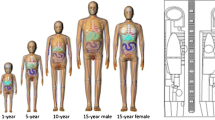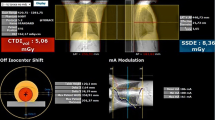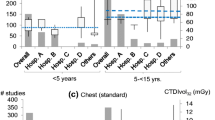Abstract
Computed tomography (CT) is the single biggest ionising radiation risk from anthropogenic exposure. Reducing unnecessary carcinogenic risks from this source requires the determination of organ and tissue absorbed doses to estimate detrimental stochastic effects. In addition, effective dose can be used to assess comparative risk between exposure situations and facilitate dose reduction through optimisation. Children are at the highest risk from radiation induced carcinogenesis and therefore dosimetry for paediatric CT recipients is essential in addressing the ionising radiation health risks of CT scanning. However, there is no well-defined method in the clinical environment for routinely and reliably performing paediatric CT organ dosimetry and there are numerous methods utilised for estimating paediatric CT effective dose. Therefore, in this study, eleven computational methods for organ dosimetry and/or effective dose calculation were investigated and compared with absorbed doses measured using thermoluminescent dosemeters placed in a physical anthropomorphic phantom representing a 10 year old child. Three common clinical paediatric CT protocols including brain, chest and abdomen/pelvis examinations were evaluated. Overall, computed absorbed doses to organs and tissues fully and directly irradiated demonstrated better agreement (within approximately 50 %) with the measured absorbed doses than absorbed doses to distributed organs or to those located on the periphery of the scan volume, which showed up to a 15-fold dose variation. The disparities predominantly arose from differences in the phantoms used. While the ability to estimate CT dose is essential for risk assessment and radiation protection, identifying a simple, practical dosimetry method remains challenging.






Similar content being viewed by others
References
United Nations Scientific Committee on the Effects of Atomic Radiation (UNSCEAR) (2010) Sources and effects of ionizing radiation. UNSCEAR 2008 Report to the General Assembly. Annex A: medical radiation exposures, vol I. United Nations, New York
Mettler FA, Bhargavan M, Faulkner K, Gilley DB, Gray JE, Ibbott GS, Lipoti JA, Mahesh M, McCrohan JL, Stabin MG, Thomadsen BR, Yoshizumi TT (2009) Radiologic and nuclear medicine studies in the United States and worldwide: frequency, radiation dose, and comparison with other radiation source 1950–2007. Radiology 253(2):520–531
Brady Z, Cain TM, Johnston PN (2011) Paediatric CT imaging trends in Australia. J Med Imaging Radiat Oncol 55:132–142
National Research Council of the National Academies. Board on Radiation Effects Research (2006) Health risks from exposure to low levels of ionizing radiation: BEIR VII Phase 2. The National Academies Press, Washington, DC
International Commission on Radiological Protection (ICRP) (2007) The 2007 recommendations of the international commission on radiological protection, ICRP Publication 103. Ann ICRP 37(2–4):1–332
International Commission on Radiological Protection (ICRP) (2007) Radiological protection in medicine, ICRP Publication 105. Ann ICRP 37(6):1–64
Xu GX, Eckerman KF (2010) Handbook of anatomical models for radiation dosimetry. CRC Press, Florida
Nishizawa K, Mori S, Ohno M, Yanagawa N, Yoshida T, Akahane K, Iwai K, Wada S (2008) Patient dose estimation for multi-detector-row CT examinations. Radiat Prot Dosim 128(1):98–105
Brisse HJ, Robilliard M, Savignoni A, Pierrat N, Gaboriaud G, De Rycke Y, Neuenschwander S, Aubert B, Rosenwald JC (2009) Assessment of organ absorbed doses and estimation of effective doses from pediatric anthropomorphic phantom measurements for multi-detector row CT with and without automatic exposure control. Health Phys 97(4):303–314
Brady Z, Cain TM, Johnston PN (2011) Differences in using the international commission on radiological protection’s publications 60 and 103 for determining effective dose in paediatric CT examinations. Radiat Meas 46(12):2031–2034
Hollingsworth CL, Yoshizumi TT, Frush DP, Chan FP, Toncheva G, Nguyen G, Lowry CR, Hurwitz LM (2007) Pediatric cardiac-gated CT angiography: assessment of radiation dose. AJR Am J Roentgenol 189(1):12–18
Yoshizumi TT, Goodman PC, Frush DP, Nguyen G, Toncheva G, Sarder M, Barnes L (2007) Validation of metal oxide semiconductor field effect transistor technology for organ dose assessment during CT: comparison with thermoluminescent dosimetry. AJR Am J Roentgenol 188(5):1332–1336
ImPACT (2011) ImPACT CT dosimetry calculator, version 1.0.4. St. George’s Healthcare NHS Trust, London
Stamm G, Nagel HD (2011) CT-Expo V2.0.1: a tool for dose evaluation in computed tomography. Hannover
Le Heron JC (1993) CTDOSE. National Radiation Laboratory (NRL), Christchurch
CT Dose. National Institute of Radiation Hygiene, Herlev
ImpactDose. IBA Dosimetry, Germany
Kalender WA, Schmidt B, Zankl M, Schmidt M (1999) A PC program for estimating organ dose and effective dose values in computed tomography. Eur Radiol 9(3):555–562
Li X, Samei E, Segars WP, Sturgeon GM, Colsher JG, Frush DP (2011) Patient-specific radiation dose and cancer risk for pediatric chest CT. Radiology 259(3):862–874
Li X, Samei E, Segars WP, Sturgeon GM, Colsher JG, Toncheva G, Yoshizumi TT, Frush DP (2011) Patient-specific radiation dose and cancer risk estimation in CT: part II.Application to patients. Med Phys 38(1):408–419
Li X, Samei E, Segars WP, Sturgeon GM, Colsher JG, Toncheva G, Yoshizumi TT, Frush DP (2011) Patient-specific radiation dose and cancer risk estimation in CT: part I. Development and validation of a Monte Carlo program. Med Phys 38(1):397–407
Turner AC, Zankl M, DeMarco JJ, Cagnon CH, Zhang D, Angel E, Cody DD, Stevens DM, McCollough CH, McNitt-Gray MF (2010) The feasibility of a scanner-independent technique to estimate organ dose from MDCT scans: using CTDIvol to account for differences between scanners. Med Phys 37(4):1816–1825
Turner AC, Zhang D, Khatonabadi M, Zankl M, DeMarco JJ, Cagnon CH, Cody DD, Stevens DM, McCollough CH, McNitt-Gray MF (2011) The feasibility of patient size-corrected, scanner-independent organ dose estimates for abdominal CT exams. Med Phys 38(2):820–829
Huda W, Vance A (2007) Patient radiation doses from adult and pediatric CT. Am J Roentgenol 188(2):540–546
Thomas K, Wang B (2008) Age-specific effective doses for pediatric MSCT examinations at a large children’s hospital using DLP conversion coefficients: a simple estimation method. Pediatr Radiol 38(6):645–656
Christner JA, Kofler JM, McCollough CH (2010) Estimating effective dose for CT using dose-length product compared with using organ doses: consequences of adopting international commission on radiological protection publication 103 or dual-energy scanning. AJR Am J Roentgenol 194(4):881–889
Geleijns J, Van Unnik JG, Zoetelief J, Zweers D, Broerse JJ (1994) Comparison of two methods for assessing patient dose from computed tomography. Br J Radiol 67(796):360–365
Brix G, Lechel U, Veit R, Truckenbrodt R, Stamm G, Coppenrath EM, Griebel J, Nagel HD (2004) Assessment of a theoretical formalism for dose estimation in CT: an anthropomorphic phantom study. Eur Radiol 14(7):1275–1284
Groves AM, Owen KE, Courtney HM, Yates SJ, Goldstone KE, Blake GM, Dixon AK (2004) 16-detector multislice CT: dosimetry estimation by TLD measurement compared with Monte Carlo simulation. Br J Radiol 77(920):662–665
Lechel U, Becker C, Langenfeld-Jager G, Brix G (2009) Dose reduction by automatic exposure control in multidetector computed tomography: comparison between measurement and calculation. Eur Radiol 19(4):1027–1034
Lee C, Kim KP, Long D, Fisher R, Tien C, Simon SL, Bouville A, Bolch WE (2011) Organ doses for reference adult male and female undergoing computed tomography estimated by Monte Carlo simulations. Med Phys 38(3):1196–1206
Kim KP, Lee J, Bolch WE (2011) CT dosimetry computer codes: their influence on radiation dose estimates and the necessity for their revision under new ICRP radiation protection standards. Radiat Prot Dosim 146(1–3):252–255
Deak P, van Straten M, Shrimpton PC, Zankl M, Kalender WA (2008) Validation of a Monte Carlo tool for patient-specific dose simulations in multi-slice computed tomography. Eur Radiol 18(4):759–772
International Commission on Radiological Protection (ICRP) (1991) 1990 Recommendations of the international commission on radiological protection, ICRP Publication 60. Ann ICRP 21(1–3):1–201
Snyder WS, Ford MR, Warner GG, Fisher HL (1969) Estimates of absorbed fractions for monoenergetic photon sources uniformly distributed in various organs of a heterogeneous phantom. MIRD Pamphlet No. 5. Society of Nuclear Medicine, New York
Cristy M (1980) Mathematical phantoms representing children of various ages for use in estimates of internal dose. US Nuclear Regulatory Commission Report. NUREG/CR-1159 (also Oak Ridge National Laboratory Report. ORNL/NUREG/TM-367). Oak Ridge National Laboratory, Oak Ridge
Cristy M, Eckerman KF (1987) Specific absorbed fractions of energy at various ages from internal photon sources (I. Methods). Report ORNL/TM-8381/V1. Oak Ridge National Laboratory, Oak Ridge
Kramer R, Zankl M, Williams G, Drexler G (1982) The calculation of dose from external photon exposures using reference human phantoms and Monte Carlo methods Part I: The male (ADAM) and female (EVA) adult mathematical phantoms. GSF Report S-885. National Research Center for Environment and Health (GSF), Neuherberg
Zankl M, Veit R, Williams G, Schneider K, Fendel H, Petoussi N, Drexler G (1988) The construction of computer tomographic phantoms and their application in radiology and radiation protection. Radiat Environ Biophys 27(2):153–164
Caon M, Bibbo G, Pattison J (1999) An EGS4-ready tomographic computational model of a 14-year-old female torso for calculating organ doses from CT examinations. Phys Med Biol 44(9):2213–2225
Saito K, Wittmann A, Koga S, Ida Y, Kamei T, Funabiki J, Zankl M (2001) Construction of a computed tomographic phantom for a Japanese male adult and dose calculation system. Radiat Environ Biophys 40(1):69–75
Petoussi-Henss N, Zanki M, Fill U, Regulla D (2002) The GSF family of voxel phantoms. Phys Med Biol 47(1):89–106
Kramer R, Vieira JW, Khoury HJ, Lima FR, Fuelle D (2003) All about MAX: a male adult voxel phantom for Monte Carlo calculations in radiation protection dosimetry. Phys Med Biol 48(10):1239–1262
Fill UA, Zankl M, Petoussi-Henss N, Siebert M, Regulla D (2004) Adult female voxel models of different stature and photon conversion coefficients for radiation protection. Health Phys 86(3):253–272
Lee C, Park SH, Lee JK (2006) Development of the two Korean adult tomographic computational phantoms for organ dosimetry. Med Phys 33(2):380–390
Lee C, Williams JL, Bolch WE (2006) Whole-body voxel phantoms of paediatric patients—UF Series B. Phys Med Biol 51(18):4649–4661
Lee C, Lodwick D, Hasenauer D, Williams JL, Bolch WE (2007) Hybrid computational phantoms of the male and female newborn patient: NURBS-based whole-body models. Phys Med Biol 52(12):3309–3333
Lee C, Lodwick D, Williams JL, Bolch WE (2008) Hybrid computational phantoms of the 15-year male and female adolescent: applications to CT organ dosimetry for patients of variable morphometry. Med Phys 35(6):2366–2382
Lee C, Lodwick D, Hurtado J, Pafundi D, Williams JL, Bolch WE (2010) The UF family of reference hybrid phantoms for computational radiation dosimetry. Phys Med Biol 55(2):339–363
Xu XG, Taranenko V, Zhang J, Shi C (2007) A boundary-representation method for designing whole-body radiation dosimetry models: pregnant females at the ends of three gestational periods—RPI-P3, -P6 and -P9. Phys Med Biol 52(23):7023–7044
Segars WP, Mahesh M, Beck TJ, Frey EC, Tsui BM (2008) Realistic CT simulation using the 4D XCAT phantom. Med Phys 35(8):3800–3808
Li X, Samei E, Segars WP, Sturgeon GM, Colsher JG, Frush DP (2008) Patient-specific dose estimation for pediatric chest CT. Med Phys 35(12):5821–5828
International Commission on Radiological Protection (ICRP) (2002) Basic anatomical and physiological data for use in radiological protection: reference values, ICRP Publication 89. Ann ICRP 32(3–4):1–277
International Commission on Radiological Protection (ICRP) (2006) Human alimentary tract model for radiological protection, ICRP Publication 100. Ann ICRP 36:1–327
Jones DG, Shrimpton PC (1991) Survey of CT Practice in the UK. Part 3: normalised organ doses calculated using Monte Carlo techniques. NRPB-R250. National Radiological Protection Board (NRPB), Chilton
Jones DG, Shrimpton PC (1993) Normalized organ doses for X-ray computed tomography calculated using Monte Carlo techniques. NRPB SR-250. National Radiological Protection Board (NRPB), Chilton
Zankl M, Panzer W, Drexler G (1991) The calculation of dose from external photon exposures using reference human phantoms and Monte Carlo methods Part VI: organ doses from computed tomographic examinations. GSF Report 30/91. National Research Center for Environment and Health (GSF), Neuherberg
Zankl M, Panzer W, Drexler G (1993) Tomographic anthropomorphic models, part II: organ doses from computed tomographic examinations in paediatric radiology. GSF Report 30/93. National Research Centre for Environment and Health (GSF), Neuherberg
Shrimpton PC, Edyvean S (1998) CT scanner dosimetry. Br J Radiol 71(841):1–3
Lewis M, Edyvean S, Sassi S, Kiremidjian H, Keat N, Britten A (2000) Estimating patient dose on current CT scanners: results of the ImPACT CT dose survey. RAD Mag 26:17–18
Nagel HD (2002) Radiation exposure in computed tomography: fundamentals, influencing parameters, dose assessment, optimisation, scanner data, terminology. CTB Publications, Hamburg
Shrimpton PC (2004) 2004 CT quality criteria. Appendix C: assessment of patient dose in CT (also NRPB-PE/1/2004). National Radiological Protection Board (NRPB), Oxon
Veit R, Zankl M, Petoussi N, Mannweiler E, Williams G, Drexler G (1989) Tomographic anthropomorphic models, part I: construction technique and description of models of an 8 week old baby and a 7 year old child. GSF Report 3/89. National Research Centre for Environment and Health (GSF), Neuherberg
Shrimpton PC, Wall BF (2000) Reference doses for paediatric computed tomography. Radiat Prot Dosim 90(1–2):249–252
Chapple CL, Willis S, Frame J (2002) Effective dose in paediatric computed tomography. Phys Med Biol 47(1):107–115
Khursheed A, Hillier MC, Shrimpton PC, Wall BF (2002) Influence of patient age on normalized effective doses calculated for CT examinations. Br J Radiol 75(898):819–830
Shrimpton PC, Hillier MC, Lewis MA, Dunn M (2006) National survey of doses from CT in the UK:2003 Br J Radiol 79(948):968–980
Shrimpton PC, Wall BF (2009) Effective dose and dose-length product in CT. Radiology 250(2):604–605
Martin CJ (2007) Effective dose: how should it be applied to medical exposures? Br J Radiol 80(956):639–647
Zankl M, Panzer W, Petoussi-Henss H, Drexler G (1995) Organ doses for children from computed tomographic examinations. Radiat Prot Dosim 57(1–4):393–396
STUK (2008) PCXMC dose calculations, version 2.0. Radiation and Nuclear Safety Authority (STUK), Helsinki
Tapiovaara M, Siiskonen T (2008) PCXMC: a PC-based Monte Carlo program for calculating patient doses in medical X-ray examinations, 2nd edn. Report STUK-A139. Radiation and Nuclear Safety Authority (STUK), Helsinki
Lee C, Lee C, Staton RJ, Hintenlang DE, Arreola MM, Williams JL, Bolch WE (2007) Organ and effective doses in pediatric patients undergoing helical multislice computed tomography examination. Med Phys 34(5):1858–1873
Zankl M, Fill U, Petoussi-Henss N, Regulla D (2002) Organ dose conversion coefficients for external photon irradiation of male and female voxel models. Phys Med Biol 47(14):2367–2385
Deak PD, Smal Y, Kalender WA (2010) Multisection CT protocols: sex- and age-specific conversion factors used to determine effective dose from dose-length product. Radiology 257(1):158–166
Lindskoug BA (1992) The reference man in diagnostic radiology dosimetry. Br J Radiol 65(773):431–437
McCollough CH, Zink FE (1999) Performance evaluation of a multi-slice CT system. Med Phys 26(11):2223–2230
Goldman LW (2008) Principles of CT: multislice CT. J Nucl Med Technol 36(2):57–68
Brady Z, Wallace AB, Wilkinson L, Heggie JCP, Hayton A, Einsiedel P, Forsythe A, Mathews JD (2011) Introduction to the Australian study of low dose radiation—assessing the effects of CT scans in childhood (EPSM ABEC 2011 conference proceedings). Australas Phys Eng Sci Med 34(4):611
Pearce MS, Salotti JA, McHugh K, Metcalf W, Kim KP, Craft AW, Parker L, Ron E (2011) CT scans in young people in Northern England: trends and patterns 1993–2002. Pediatr Radiol 41(7):832–838
Hricak H, Brenner DJ, Adelstein SJ, Frush DP, Hall EJ, Howell RW, McCollough CH, Mettler FA, Pearce MS, Suleiman OH, Thrall JH, Wagner LK (2011) Managing radiation use in medical imaging: a multifaceted challenge. Radiology 258(3):889–905
International Commission on Radiological Protection (ICRP) (2009) Adult reference computational phantoms, ICRP Publication 110. Ann ICRP 39(2):1–164
Zankl M, Becker J, Fill U, Petoussi-Henss N, Eckerman KF (2005) GSF male and female adult voxel models representing ICRP reference man—the present status, the Monte Carlo method: versatility unbounded in a dynamic computing world. American Nuclear Society, LaGrange Park
van der Molen AJ, Geleijns J (2007) Overranging in multisection CT: quantification and relative contribution to dose-comparison of four 16-section CT scanners. Radiology 242(1):208–216
Acknowledgments
The authors would like to thank Luke Wilkinson at St. Vincent’s Hospital Melbourne and Anthony Wallace at ARPANSA for their advice and many useful discussions.
Author information
Authors and Affiliations
Corresponding author
Rights and permissions
About this article
Cite this article
Brady, Z., Cain, T.M. & Johnston, P.N. Comparison of organ dosimetry methods and effective dose calculation methods for paediatric CT. Australas Phys Eng Sci Med 35, 117–134 (2012). https://doi.org/10.1007/s13246-012-0134-4
Received:
Accepted:
Published:
Issue Date:
DOI: https://doi.org/10.1007/s13246-012-0134-4




